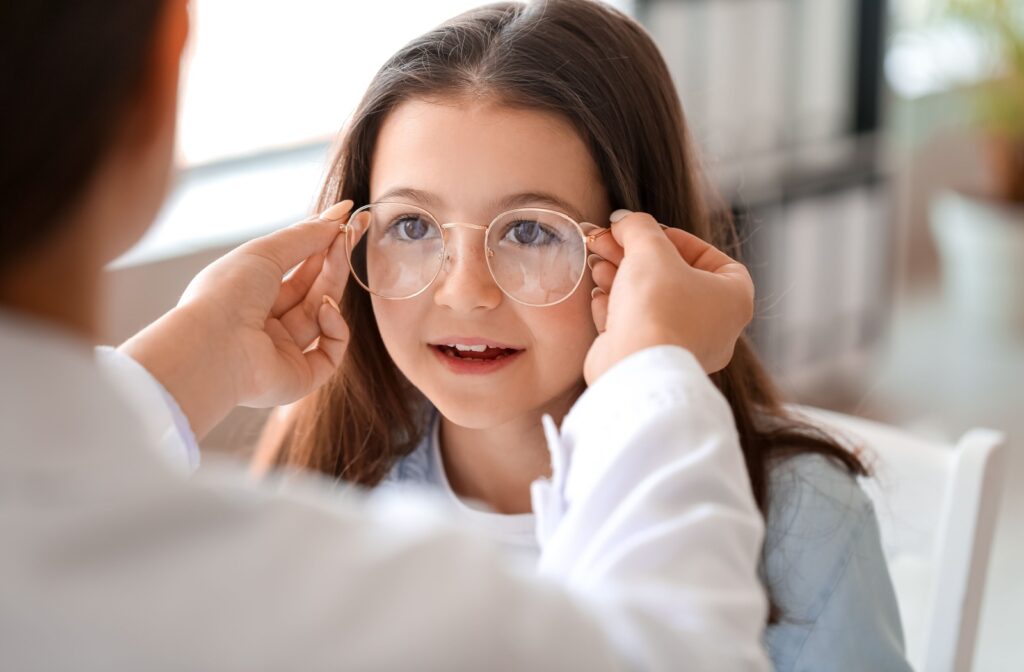Many parents wonder if their child will develop nearsightedness, especially if they have a family history of myopia. The connection between genetics and myopia is well established, but it is not the only factor that shapes vision health.
Myopia can be passed down through families, but environmental habits like screen time near work and outdoor activity also play a major role in how and when it appears.
By explaining the balance between genetic risk and daily habits, you can help families make informed choices that support healthier vision during childhood and beyond.
The Genetic Foundation of Myopia
Myopia often runs in families, but genetics alone does not explain why some children develop nearsightedness and others do not. Research shows that myopia results from a combination of genetic factors and everyday habits, making both important when assessing risk.
How Eye Genetics Work
Myopia is influenced by a mix of genes rather than following a simple dominant or recessive pattern. Researchers have discovered hundreds of small genetic changes linked to nearsightedness. These small effects add up to increase a person’s overall risk.
Studies show that 60 to 90 percent of the difference in nearsightedness between people comes from genetics. Still, having a genetic tendency does not mean someone will definitely develop myopia.
Key Genetic Factors
A few important genes play a role in how the eyes grow and develop:
- PAX6 helps guide early eye development
- GJD2 is linked to eye growth and length
- RASGRF1 plays a role in how the eye regulates growth
These genes interact with each other and with environmental factors like screen time and outdoor activity, making myopia risk a combination of both genetics and lifestyle.
Parental Myopia & Child Risk
Children with one or more myopic parents are significantly more likely to develop nearsightedness. Studies have shown that having one myopic parent approximately doubles a child’s risk, and having two myopic parents increases it even further.
It’s important to note that while family history clearly influences risk, environmental factors like outdoor time, screen use, and near-work habits also play a role in whether that genetic tendency leads to myopia.
Environmental Factors That Influence Genetic Expression
Genetics may set the foundation for myopia risk, but daily habits often determine whether that risk turns into nearsightedness. Two key environmental factors, near work and outdoor time, have an impact on how myopia develops and progresses.

The Role of Near Work
Extended near work activities can trigger myopia development in genetically susceptible individuals. This includes:
- Reading at close distances
- Computer and digital device use
- Detailed handwork or crafts
- Limited outdoor time
Children with a genetic predisposition may develop myopia earlier or more severely when exposed to high near-work demands.
Outdoor Time & Light Exposure
Bright outdoor light appears protective against myopia development, even in genetically susceptible children. The mechanism involves:
- Increased dopamine release in the retina
- Better regulation of eye growth
- Reduced axial length elongation
- Improved visual development
At least 2 hours of daily outdoor time can help mitigate the genetic risk of myopia by encouraging distance work for the eye muscles.
Early Detection & Genetic Risk Assessment
Identify High-Risk Patients
Comprehensive family history assessment helps identify children at elevated genetic risk:
- Document parental age of myopia onset
- Record the severity of parental myopia
- Note family patterns of progression
- Assess sibling refractive status
Early identification allows for proactive intervention before myopia develops or progresses significantly.
Genetic Testing Considerations
While genetic testing for myopia exists, current clinical utility remains limited. Most myopia results from multiple genetic variants with small individual effects, making prediction challenging. However, genetic testing may become more valuable as:
- Polygenic risk scores improve
- Treatment personalization advances
- Precision medicine approaches develop
Treatment for Myopia
Managing myopia often entails a combination of treatments and proactive lifestyle adjustments. Here are some of the treatment options available today:
- Glasses and contact lenses: Prescription glasses and contact lenses remain the most commonly used methods for correcting myopia. These tools help focus light correctly on the retina, improving vision clarity.
- Orthokeratology (Ortho-K): Orthokeratology involves wearing specialized rigid gas-permeable contact lenses overnight to temporarily reshape the cornea.
- Atropine eye drops: Low-dose atropine eye drops are a promising treatment option to slow myopia progression, particularly in children.
- Lifestyle and environmental changes: Encouraging outdoor activities and limiting screen time are proven strategies for managing myopia progression.
By tailoring treatment plans to individual needs and regularly monitoring eye health, patients can achieve better outcomes and minimize the impact of myopia on their daily lives.
Building a Myopia Management Program
Myopia develops through a mix of genetics and environment. While family history increases risk, daily habits like screen use and time outdoors have a big impact on how myopia progresses. Early detection and proactive care can make a real difference.
At Eye Care Center of Colorado Springs, we focus on identifying children at higher risk and offering personalized treatment plans that combine proven myopia control methods with practical lifestyle guidance. With the right approach, it is possible to slow progression and support long-term eye health. Book an appointment today to learn how we can help protect your child’s vision.


